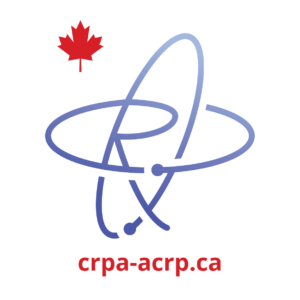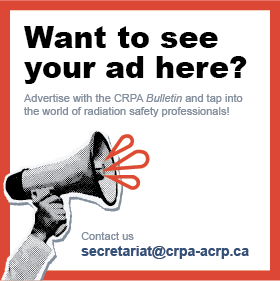2025 Anthony J. MacKay Student Paper Contest: Abstracts

Each year, the Student and Young Professionals Committee organizes the Anthony J. MacKay Student Paper Contest in conjunction with the CRPA annual conference. The contest is open to all students enrolled full-time in a Canadian college or university program related to the radiation sciences.
Entrants must submit an abstract of no more than 750 words on a topic that is related to some aspect of radiation; the topic is intentionally kept broad to encourage participation from a wide range of students.
Three finalists are selected to present their work at the conference in a plenary session. Here are the abstracts submitted by this year’s finalists.
- AI-Driven Enhancement of Low-Count Lung Scintigraphy: Optimizing Radiation Safety and Imaging Efficiency with cGANs by Amir Jabbarpour, PhD program, Department of Physics, Carleton University
- Enhancing Eye Dose Monitoring in Radiation Protection: Evaluating Hp(0.07) and OSLDs as an Alternative to Hp(3) by Minahil Manzoor, MASc program, Ontario Tech University
- Lens of Eye Dose Assessment for Nuclear Medicine and PET Technologists by Olivia Sharp, Medical Radiation Science, joint program at University of Toronto and The Michener Institute of Education at University Health Network
AI-Driven Enhancement of Low-Count Lung Scintigraphy: Optimizing Radiation Safety and Imaging Efficiency with cGANs
Amir Jabbarpour
PhD program, Department of Physics, Carleton University
coauthors
- Siraj Ghassel, University of Ottawa
- Eric Moulton, Jubilant DraxImage Inc.
- Jochen Lang, University of Ottawa
- Ran Klein, The Ottawa Hospital
Background
Lung ventilation/perfusion scintigraphy is a crucial imaging tool for diagnosing pulmonary embolism. Transitioning exclusively to single photon emission computed tomography (SPECT) acquisitions presents challenges for clinicians accustomed to interpreting traditional planar lung scintigraphy. Additionally, standard acquisition protocols for lung SPECT and planar ventilation/perfusion scintigraphy, designed to produce high-quality images, are time-consuming and prone to patient motion artifacts. This can lead to patient discomfort and necessitate repeat imaging to obtain clinically acceptable scans. This study explores the potential of conditional generative adversarial networks (cGANs) to generate high-quality pseudo-planar images from either low-dose SPECT projection data or low-count resampled planar images. By leveraging AI-driven enhancement, this approach aims to
- significantly reduce radiation dose,
- minimize patient motion artifacts, and
- decrease the need for redundant imaging while preserving diagnostic accuracy.
Methods
We retrospectively analyzed 704 patients from The Ottawa Hospital who underwent ventilation/perfusion (V/Q) scans for suspected pulmonary embolism between June 2017 and January 2023. Only perfusion images acquired using 99m-Tc MAA were included. Perfusion images were obtained in six standard projections—anterior, posterior, right and left posterior oblique, and right and left anterior oblique—using eight SPECT machines from two vendors.
Each projection was recorded until reaching a total of 600K counts using a 256 × 256 matrix. Planar acquisition averaged 120.0 ± 54.7 seconds. SPECT acquisition followed immediately, using 128 projections with an acquisition time of 8 seconds per stop and a 128 × 128 matrix. The best-matching SPECT projection for each planar projection was determined automatically by selecting the one with the highest Pearson correlation coefficient. The SPECT/planar count ratio was calculated and used to Poisson-resample the planar images, generating synthetic low-count images with Poisson noise levels matching the SPECT projections.
To enhance these low-count images, a conditional generative adversarial network (cGAN) was trained using an L1+Perceptual+GAN loss function over 300 epochs. The training dataset consisted of synthetic resampled planar images paired with their corresponding full-count planar images. Image intensity values were normalized between 0 and 1, and SPECT projections were upsampled to a 256 × 256 matrix before being fed into the cGAN. Training, validation, and test sets were created with an 80:10:10 split.
To evaluate the model’s performance, mean squared error (MSE), peak signal-to-noise ratio (PSNR), and structural similarity index measure (SSIM) were calculated, comparing low-count synthetic images, low-count SPECT projections, and their AI-enhanced results against high-count planar images. Statistical comparisons were performed using the Wilcoxon rank-sum test.
Results
The planar to SPECT projection count ratios were 0.078 ± 0.047. By visual inspection, we show that subsegmental and segmental perfusion defects can still be discerned after enhancement and that no new defects are introduced, demonstrating that diagnostic information is preserved despite ~10-fold count loss.
Synthetic and SPECT projections had similar performance metrics both before and after AI enhancement. All performance metrics showed significant improvements with AI enhancement. Specifically, for the SPECT projection, the median ± interquartile range (IQR) of mean squared error (MSE) decreased from 0.59 ± 0.08 to 0.72 ± 0.07; peak signal-to-noise ratio (PSNR) increased from 21.1 ± 1.9 to 27.7 ± 1.6; and structural similarity index (SSIM) improved from 7.75 × 10–³ ± 3.39 × 10–³ to 1.70 × 10–³ ± 8.70 × 10–⁴. All changes were statistically significant (p < 10–⁵).
Conclusions
The proposed cGAN model effectively enhances low-count lung scintigraphic images, generating high-quality pseudo-planar images from both low-dose SPECT projection data and low-count resampled planar images. Given that both low-dose and fast-scan paradigms are inherently two sides of the same coin, Poisson noise, which degrades image quality and diagnostic reliability, AI-driven enhancement offers a crucial solution.
By mitigating the effects of noise, this approach enables a reduction in administered radiopharmaceutical activity, thereby lessening patient absorbed dose while maintaining diagnostic accuracy. Additionally, it supports faster acquisition protocols, improving clinical efficiency, reducing patient discomfort, and minimizing motion-related artifacts. Future research will explore its applicability to ventilation studies, further reinforcing its role in optimizing nuclear medicine imaging.
Enhancing Eye Dose Monitoring in Radiation Protection: Evaluating Hp(0.07) and OSLDs as an Alternative to Hp(3)
Minahil Manzoor
MASc program, Ontario Tech University
coauthor
Ed Waller, Ontario Tech University
Background
Occupational exposure to ionizing radiation is a significant concern for medical workers, particularly those in interventional radiology and nuclear medicine. The International Commission on Radiological Protection (ICRP) has recommended stricter dose limits for the eye lens as a result of radiation-induced cataract formation.[1] Traditionally, Hp(3) dosimeters have been the preferred metric for assessing eye dose, but, due to limited availability, Hp(0.07) dosimeters are often used instead.[2]
While thermoluminescent dosimeters (TLDs) have commonly been used for eye dose monitoring, optically stimulated luminescent dosimeters (OSLDs) offer benefits such as higher sensitivity, reusability, and lower fading rates.
This study evaluates the feasibility of using Hp(0.07) dosimeters, measured with OSLDs, as an alternative for eye dose monitoring in radiation protection. Specifically, it aims to
- assess the correlation between Hp(0.07) and Hp(3) using OSLDs under controlled irradiation conditions,
- evaluate OSLD dose accuracy relative to Monte-Carlo-derived Hp(3) reference doses,
- investigate the response of nanodot OSLDs to photon and beta radiation fields,
- develop and test a prototype annealing system for OSLD reuse, and
- optimize annealing conditions for efficient dose resetting using different LED light sources.
Methods
This study builds on the 2016 European Radiation Dosimetry Group (EURADOS) report on eye lens dosimetry,[3] using both photon and beta irradiations to evaluate nanodot and inlight OSLDs. Controlled irradiation experiments were conducted using custom 3D-printed PMMA eye phantoms, selected for their tissue-equivalent properties.[4]
For photon irradiations, air kerma values were converted into Hp(3) equivalents using Monte Carlo (MC) simulation-based conversion coefficients. OSLDs were exposed, and their dose measurements were recorded using the MicroStar reader system. Accuracy was evaluated by comparing measured doses to expected Hp(3) values derived from air kerma-to-Hp(3) conversions.
For beta irradiations, standardized beta sources were used to examine OSLD response across different beta energy spectra. Dose response characteristics, including energy dependence and signal fading, were analyzed to determine the feasibility of nanodots for accurate eye lens dosimetry in mixed radiation fields.[5]
An OSLD annealer was designed to reset irradiated nanodots for multiple measurement cycles. The annealer employed blue, green, and white LED light sources to optimize annealing conditions. Experimental trials assessed annealing efficiency by exposing nanodots to varying radiation doses and rereading dose levels at five-minute intervals using the MicroStar II system. The most effective light source was determined based on the time required to reduce stored dose levels below detectable limits.[6]
Results
Preliminary results show a strong correlation between Hp(0.07) and Hp(3), confirming the feasibility of using Hp(0.07) as a surrogate for eye dose assessment. OSLD readings exhibited consistent performance across different radiation fields, with lower fading rates than traditional TLDs.
The annealer successfully reset OSLDs, eliminating residual signals and ensuring accurate dose measurements across reuse cycles.
- Bue LED light (470 nm) achieved the fastest annealing times, reducing doses below 8 Gy within 30 minutes and doses near 20 Gy within 55 minutes.
- White light required 40 minutes for doses under 8 Gy and 70 minutes for doses near 20 Gy.
- Green light was the least effective, requiring 90 and 140 minutes, respectively.
These findings suggest that blue LED light is the most efficient annealing method for nanodot OSLDs, enhancing reusability and reducing measurement uncertainties.
Conclusion
This study demonstrates that Hp(0.07) can serve as a viable alternative to Hp(3) in eye dose assessments and highlights the advantages of OSLDs over conventional TLDs for radiation protection. Implementing an OSLD-based monitoring system, combined with an efficient annealing process, could improve the accuracy and efficiency of lens dose monitoring programs.
The development of a low-cost OSLD annealer further supports the feasibility of integrating nanodot OSLDs into routine monitoring. The use of blue LED light for annealing significantly reduces processing time, allowing for faster and more effective reuse of dosimeters.
Future research should refine calibration methodologies, validate findings in real-world occupational settings, and explore the long-term effects of repeated annealing on OSLD sensitivity.
____________________
[1] International Commission on Radiological Protection. (2012). ICRP statement on tissue reactions: Early and late effects of radiation in normal tissues and organs—Threshold doses for tissue reactions in a radiation protection context (ICRP Publication 118). Annals of the ICRP, 41(1/2).
[2] Behrens, R., & Dietze, G. (2010). Monitoring the eye lens: Which dose quantity is adequate? Physics in medicine and biology, 55(14), 4047–4062. https://doi.org/10.1088/0031-9155/55/14/007.
[3] Clairand, I., Behrens, R., Brodecki, M., Carinou, E., Domienik-Andrzejewska, J., Ginjaume, M., Hupe, O., & Roig, M. (2018). EURADOS 2016 intercomparison exercise of eye lens dosemeters. Radiation protection dosimetry, 182(3), 317–322. https://doi.org/10.1093/rpd/ncy067.
[4] ICRU. (1989). Tissue substitutes in radiation dosimetry and measurement. International Commission on Radiation Units and Measurements. https://www.icru.org/report/tissue-substitutes-in-radiation-dosimetry-and-measurement-report-44/.
[5] Al-Senan, R. M., & Hatab, M. R. (2011). Characteristics of an OSLD in the diagnostic energy range. Medical Physics, 38(8), 4396–4405. https://doi.org/10.1118/1.3602456.
[6] Abraham, S. A., Frank, S. J., & Kearfott, K. J. (2017). An Efficient, Affordable Optically Stimulated Luminescent (OSL) Annealer. Health physics, 113(1), 2–12. https://doi.org/10.1097/HP.0000000000000677.
Lens of Eye Dose Assessment for Nuclear Medicine and PET Technologists
Olivia Sharp
Medical Radiation Science, joint program at University of Toronto and The Michener Institute of Education at University Health Network
coauthor
Matthew Bernacci, University Health Network
Background
In 2021, the Canadian Nuclear Safety Commission (CNSC) adjusted the equivalent dose limit for the lens of the eye to 50 mSv in a one-year period based on a recommendation made by the International Commission on Radiological Protection (ICRP). This is a significant reduction from the previous limit of 150 mSv in a year.
CNSC has suggested a review of workplace hazards to determine if additional safety practices need to be implemented to protect the lens of the eye. Situations that pose an increased risk were outlined by CNSC, such as those subject to non-uniform exposures to the eye and those exposed to weakly penetrating radiation. Non-uniform fields can occur in situations when the trunk of the body is shielded but not the eyes, or when the head is closer to the source than the body (for example, when viewing or preparing a syringe containing medical isotopes for nuclear medicine [NM] and positron emission tomography [PET] procedures).
The goal of this research was to examine exposure to the lens of the eye and compare it to doses recorded by whole-body (WB) dosimeters.
Methods
A total of 8 workers in NM and PET were assigned Mirion Type 27 (LiF:Mg, Ti TLD100 chip) eye dosimeters to wear for approximately 2 quarters (6 months). These were worn with previously assigned personal WB dosimeters and ring extremity thermoluminescent dosimeters (TLDs). Staff were selected based on having the highest WB equivalent doses from CNSC licensed activities.
The dosimeters were worn near the eye on the front of the face. Workers were provided safety glasses with eye dosimeters attached or a secondary option of securing the dosimeters to their medical masks at approximately equal distance from the lens of the eye.
It is worth noting that the staff rotate through PET and NM locations. In the first quarter, a single badge per wearer was assigned for both locations. In the second quarter, badges were assigned per location (2 per wearer) and dose results were summed. The number of procedures performed by the workers was recorded and considered.
Results
Theoretical doses were conservatively calculated to include exposure from WB dosimeters. This was considered extra dose incurred per quarter from non-uniform fields (when the head was closer to the source than the torso WB dosimeter, at 50 cm distance).
It was assumed that each person might spend a maximum of 10 seconds at a 10 cm source-to-eye distance per procedure. This occurs when transferring stock upon receipt to the L-block, leaning around the L-block for better view when drawing up a dose, or briefly during patient dose administration via IV line.
Staff approximately 5 feet in height or shorter have noted issues being able to view activity being drawn up in the syringe through the L-block and have used a stool. Similarly, tall staff are potentially exposed when viewing over the L-block. However, 10 seconds of preferentially unshielded eye exposure is a conservative estimate for each procedure performed, and shielding factors other than the syringe/vial are not considered with these calculations.
Mirion eye TLD results for part of Q1 and Q2 2024 confirmed the estimates for the staff monitored. The 3 highest quarterly exposures were
- 2.48 mSv,
- 2.15 mSv, and
- 1.97 mSv.
Conservatively extrapolating to 4 quarters, dose results for the lens of the eye are slightly below 10 mSv annually and well within the 50 mSv/year lens of eye dose limit.
When comparing 2024 Q2 eye TLD results total and 2024 Q2 WB TLD results total (mSv), one can see that WB results align well with lens of eye dose results:
- For wearers 001, 002, 003, 004, and 008, the difference between WB and eye dose readings only ranges from 0.07 to 0.64 mSv.
- For wearers 005, 006, and 007, results are inconclusive as 2 PET and 1 NM eye TLDs were lost or not processed.
For those not involved with PET isotopes, there is a lower dose risk. This is evident in the 2024 Q2 eye TLD results, as the highest exposed individuals had majority of their dose coming from PET location contribution (2.08 mSv, 1.59 mSv, and 1.72 mSv, respectively).
Conclusion
Based on the literature review along with the calculated estimates, the NM and PET staff are not expected to exceed the CNSC dose limit of 50mSv/year. It is worth noting the additional finding of PET procedures contributing a higher exposure to the eye. Since measured and calculated doses align for both eye and WB, it can be recommended that WB dosimeters are representative of the lens of eye dose as well.
See related articles:
2025 Anthony J. MacKay Student Paper Contest: Meet This Year’s Finalists, May 30, 2025
2024 Anthony J. MacKay Student Paper Contest: Meet This Year’s Finalists, June 7, 2024
2024 Anthony J. MacKay Student Paper Contest: Abstracts, June 4, 2024
2023 Anthony J. MacKay Student Paper Contest, May 17, 2023
2022 Anthony J. Mackay Student Paper Contest Winners, February 16, 2023
2019 Anthony J. MacKay Student Paper Contest, June 7, 2019
2018 Anthony J. MacKay Student Paper Contest, May 8, 2018
Do you want to read more articles like this?
The Bulletin is published by the Canadian Radiation Protection Association (CRPA). It’s a must-read publication for radiation protection professionals in Canada. The editorial content delivers the insights, information, advice, and valuable solutions that radiation protection professionals need to stay at the forefront of their profession.
Sign up today and we’ll send you an email each time a new edition goes live. In between issues, check back often for updates and new articles.
Don’t miss an issue. Subscribe now!
Subscribe


